The Camera Lens
The camera body is simply a black box for recording images, while the lens and the film or digital sensor are responsible for image clarity. See the book for more information about caring for your lens, lens and focal length and depth of field.
Manual Focus
Focusing the lens involves moving the lens forward and backward until the image appears sharp. On manual cameras, or automatic cameras with manual focus, focus is controlled by rotating the focusing ring on the lens, located at the front of the lens. The focusing screen, seen through the camera’s viewfinder, may provide some pattern or shape as an aid to help you focus. One such device is the split-image circle, a circle with a line through the center. When the image is out-of-focus, the two halves of the circle are unaligned. Some split-image focusing screens also have a microprism collar, a ring around the split-image circle. The interior of the ring indicates focus with a coarse or fine dot pattern. If you have trouble focusing, stop, look away into the distance and then try again.
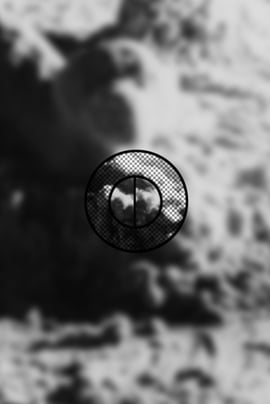
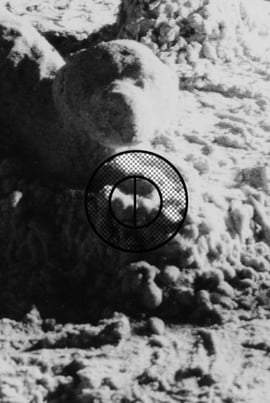 photo left: R. Modrak. Split-image focusing shows the image offset when out of focus.
photo left: R. Modrak. Split-image focusing shows the image offset when out of focus.
photo right: R. Modrak. Split-image focusing shows a continuous image when in focus.
Estimation Focusing
Some situations prohibit looking through the viewfinder to focus. You may not want to lift your camera up to your eye, at the risk of alerting your subject or making them self-conscious. It is difficult to see through the lens well enough to focus at nighttime and in dim lighting. If using a single lens reflex film camera, you can focus the lens using the distance scale printed on the side of the lens barrel. Determine the distance from the lens to the subject by measuring or guessing and turn the focusing ring until that number (in feet or meters) on the distance scale lines up with the index or distance marker. When using estimation focusing, there is a better chance that the focus will be sharp if using a wide or normal lens rather than a long lens and if using a small aperture rather than a big one.
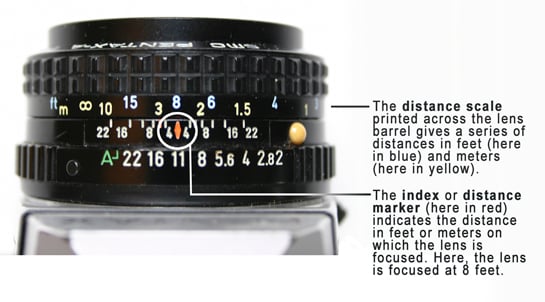 photo: R. Modrak. This lens barrel has a distance scale, printed across the barrel and an index marker that reads the distance of current focus.
photo: R. Modrak. This lens barrel has a distance scale, printed across the barrel and an index marker that reads the distance of current focus.
Predicting depth of field using the lens scale
The depth of field scale on the lens can be used to predict the depth of field in your photograph. The lens is focused on an object at approximately 1.95 feet. Using a wide aperture of f/2.8, only the subject at 1.95 feet will be in focus. Using a narrow aperture of f/22, the focused area will include everything from 1 foot to 2.5 feet.
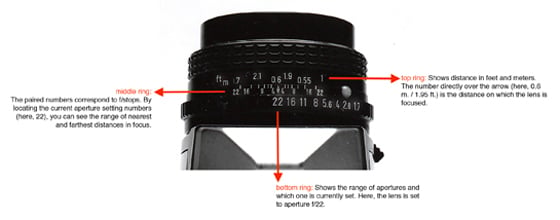 photo: Sven Kahns. Lens set to aperture f/22.
photo: Sven Kahns. Lens set to aperture f/22.
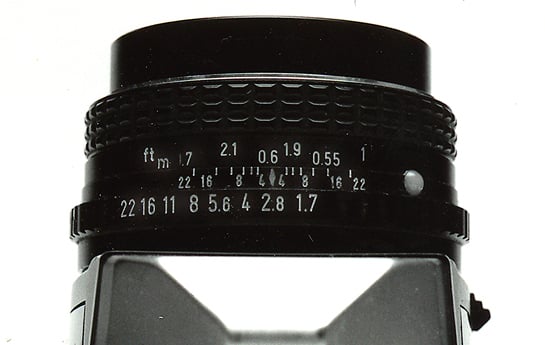 photo: Sven Kahns. Lens set to aperture f/2.8.
photo: Sven Kahns. Lens set to aperture f/2.8.
Tunnel Vision Lens and Focal Length
Lomo’s TunnelVision lens can be attached (temporarily, via a magnetic ring) to a camera to create the wide-angle effect.
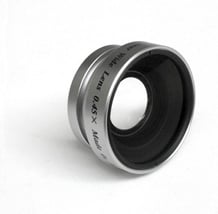
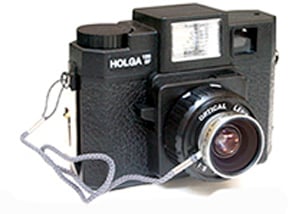 photo left: Courtesy of www.lomography.com. Lomographic Society’s TunnelVision Lens.
photo left: Courtesy of www.lomography.com. Lomographic Society’s TunnelVision Lens.
photo right:TunnelVision lens on Holga camera.

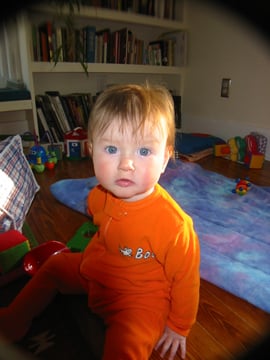 photo left: R. Modrak. Photo taken with digital camera. photo right: R. Modrak. Photo taken with digital camera equipped with TunnelVision Lens.
photo left: R. Modrak. Photo taken with digital camera. photo right: R. Modrak. Photo taken with digital camera equipped with TunnelVision Lens.
Selective Focus: Lensbaby
The Lensbaby™ attaches to any film or digital SLR body to allow faster selective focus for imagemakers who want one area of the image to be sharply focused and surrounded by gradual blur and glowing highlights. The lens offers five aperture settings so that photographers can control the diameter of the sharp area. Move the sharp area around the photo by bending the flexible lens tubing.

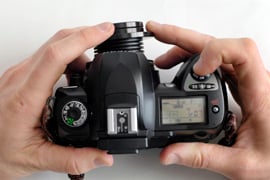 photo left: John Baird, Glasses, color photograph, 2005. Shot with Lensbaby lens.
photo left: John Baird, Glasses, color photograph, 2005. Shot with Lensbaby lens.
photo right: Lensbabies, LLC. Lensbaby on camera.
Multiple Lenses
The Lomographic Society’s SuperSampler has panoramic lenses. The Oktomat has eight lenses that trigger sequentially within 2.5 seconds. Lomo describes the cameras as “macro-cine” machines, between still photography and animated cinematography and positions them as alternatives to high-definition, digital imagery. Although the emphasis is on ACTION, the resulting images made with these cameras are relatively static, probably due to the limited range of motion that can be captured in the small range of time and the stillness of each image within the sequence. The results are more lively when animated (through a flip book or digitally), and the cameras provide a simple way of acquiring stills for such a purpose. If your goal is not action, but multiples, the Lomographic Society’s Pop 9 has nine lenses that produce nine identical images on one print.
For her work, Something Borrowed, Something New, artist Anissa Mack organized a daily bouquet toss from the pergola in Wave Hill, a public garden in the Bronx, New York. Anticipating the bride’s arrival, sunbathers, strollers, and families playing in the park wander over to wait for a bride they do not know. Her entrance, a formal and fairy-tale-like figure in white, and the subsequent toss, commemorate all weddings that previously took place in the park, a popular site for ceremonies. The park, whose sculpted landscape and greenhouse flowers are daily gifts to the public, is condensed down to this one bouquet of flowers, thrown to the public in a ceremonial gesture. The Lomo ActionSampler camera, which in one exposure takes four pictures in rapid succession, captures the arc made by the bouquet before it plummets down to the eager crowd.
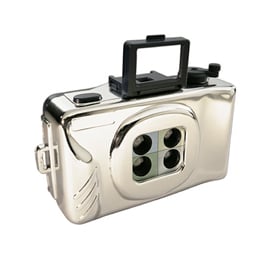
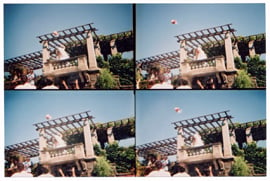
photo left: Courtesy of www.lomography.com. Lomo ActionSampler. photo right: Nick Tobier. Anissa Mack's Something Borrowed, Something New, Wave Hill. Shot with Lomo ActionSampler camera.
If using film, it is easy to make your own camera with multiple lenses by constructing a pinhole camera with several apertures. You can make multiple exposures by opening one at time or all at once. Several manufacturers offer cameras with multiple lenses.
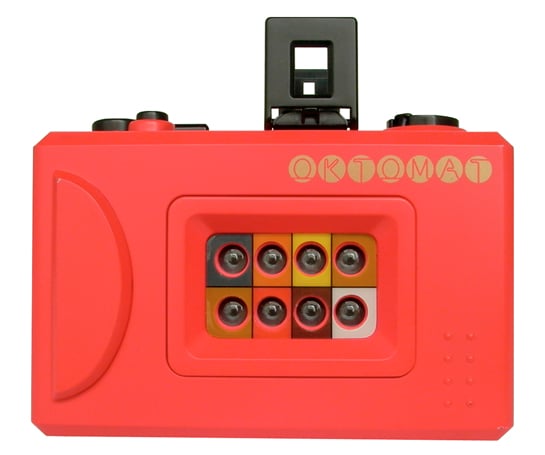 photo: Courtesy of www.lomography.com. Lomo Oktomat camera.
photo: Courtesy of www.lomography.com. Lomo Oktomat camera.
